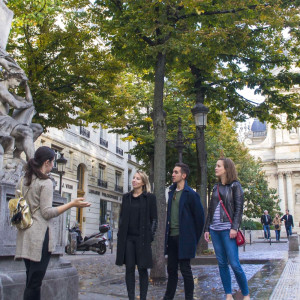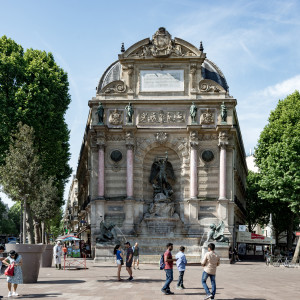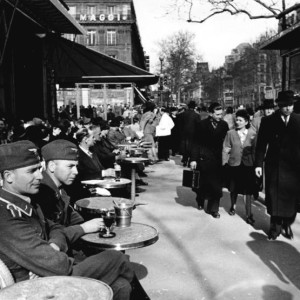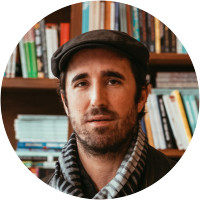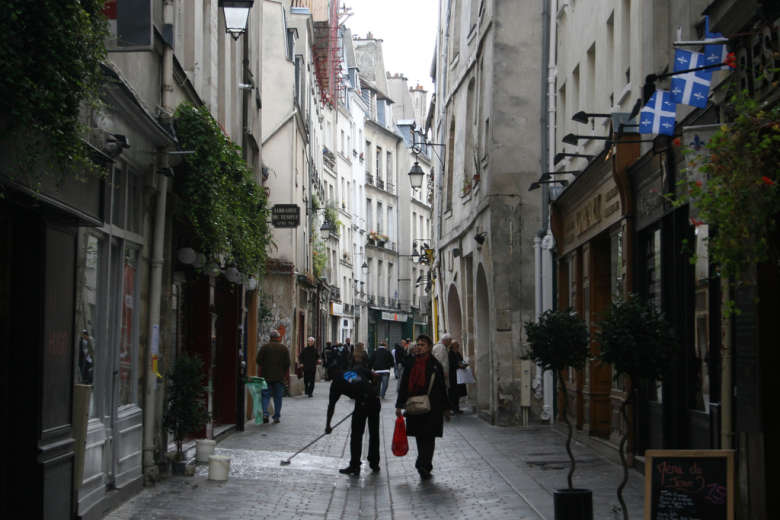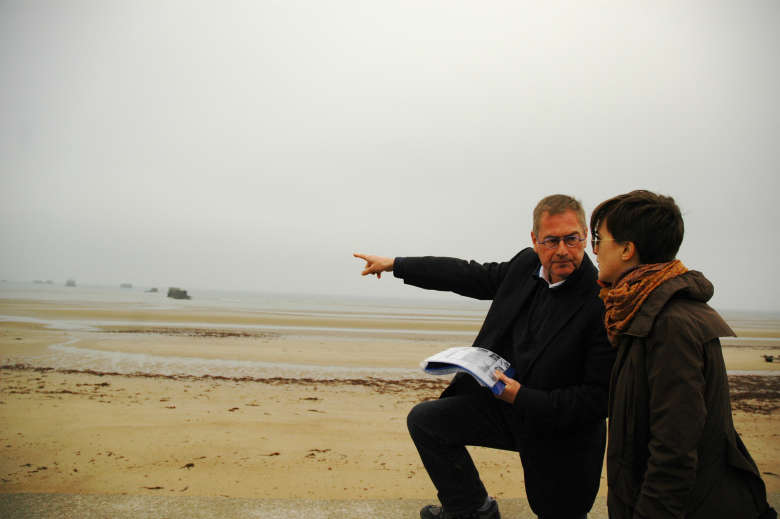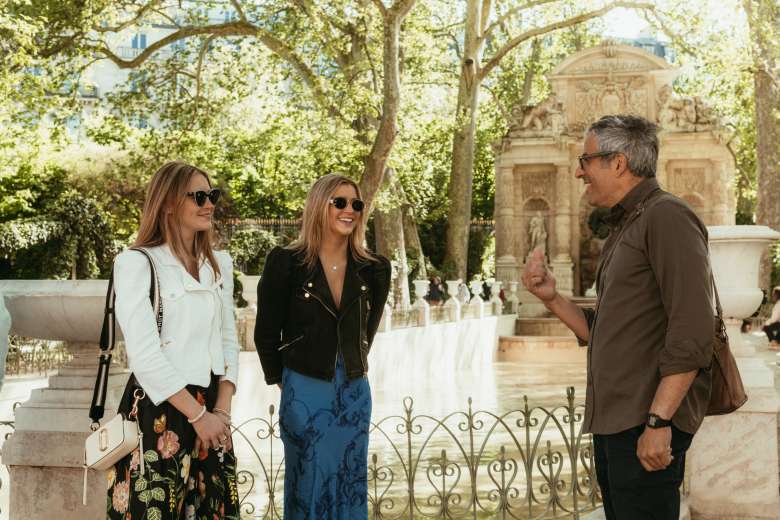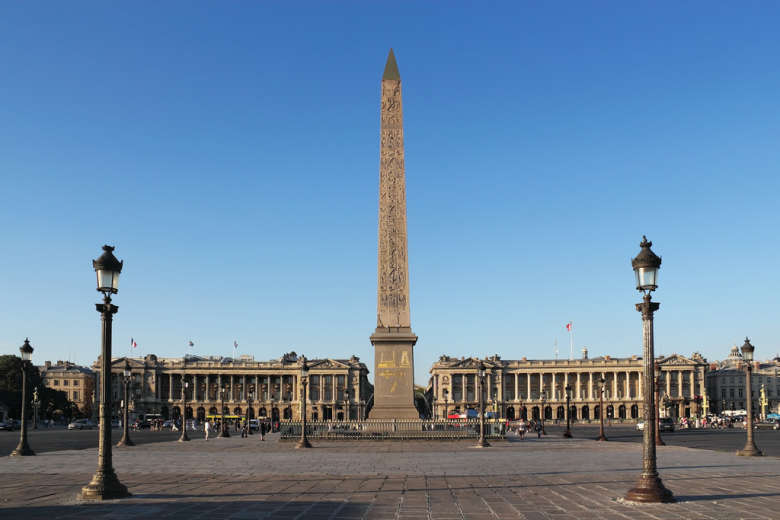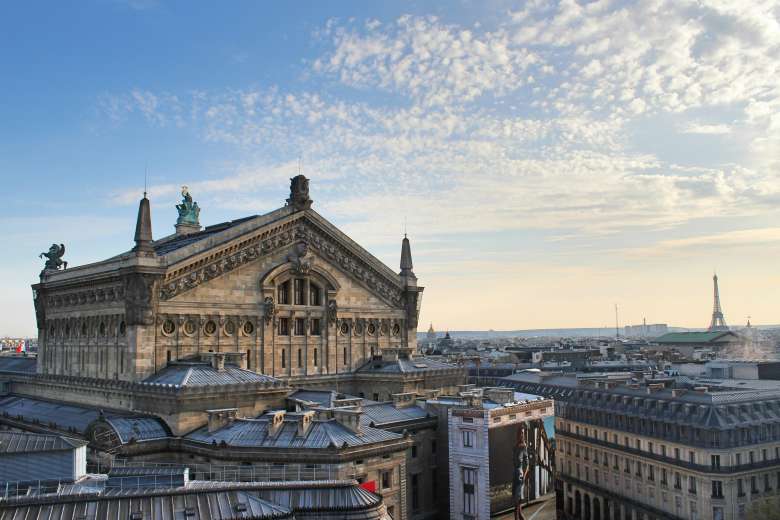Tour Details
Duration
3 hours
Product Type
Tour
Venues
- Place Saint-Michel
- Luxembourg Gardens
- Île de la Cité
- Latin Quarter
- Marais
- Mémorial des martyrs de la Déportation
- Memorial of the Shoah
Photos & Highlights
- Explore what the reality of life was like under Nazi occupation through the lens of soldiers, the deported, Resistance fighters, collaborators, and everyday citizens
- Visit iconic sites and walk historic streets while uncovering hidden stories of the men and women who fought for Paris’ Liberation
Select a date
Tour Description
In this city once gripped by Nazi occupation, wartime secrets are waiting to be revealed. You’ve read all the novels, watched all the documentaries, but here you’ll come to understand what no single piece of media can convey: the many shades of gray of life under Nazi occupation.
As you walk along the history-laden streets, you will hear echoes of those who came before. Perhaps you’ll learn more about your own family history, or your expert will share their family ties with a past not so far gone. From the most personal connections to the most well-known, you’ll see what the men and women who shaped this city’s history went through firsthand.
With the help of an expert historian, World War II in Paris will come to life. Discover the site of a pivotal riot sparked by sardines, see a hotel that once housed both Holocaust survivors and their imprisoned Nazi captors, find bullet holes in a building meant for those who served and protected, and more.
Choose this tour if...
- You are a history buff who craves a deeper understanding of daily life during the Nazi occupation
- You are an avid historical fiction reader who wants to learn the truth behind the stories you’ve read
- Your family was touched by the war, and you want a more profound insight into your own personal past
- You are looking to make collective memories with your family and give yourselves something to talk about long after your trip is over
- You want to see parts of Paris that most tourists don’t visit
Experts
Everyone from history buffs to history dabblers will learn something new
“Marie was a fabulous guide. She gave me a real look at WWII from the French perspective, which was so interesting. My husband is a real military/war buff and he learned new things from Marie. Highly recommend Marie and this tour. Money well spent.”
Discover one of Paris’ hidden sides
“Our guide, Sean, led us on an insightful walking tour that we really enjoyed. We read a lot of WWII history, but were unfamiliar with the details of what happened in Paris during the war years—and we learned a lot on this tour. It offered a new way to see and understand Paris. We enjoyed it!”
Follow in the footsteps of the French Resistance
“The tour with Aymeric was excellent! Standing in locations that were important to the Resistance effort to defeat the Nazis and made the history come alive. I highly recommend this tour for those interested in WWII and the Nazi Occupation of Paris.”
Beginning in the heart of Saint Germain des Prés, a critical location for both Nazi occupiers and the Resistance, your expert will weave tales of daily life for French, German, and American soldiers, Jews, non-Jews, Resistance fighters, and everyday citizens. From the start of the occupation to the final days of Liberation, immerse yourself in the stories of those whose footsteps once fell upon these streets.
Visit the hotel where the German OSS once operated, imagining details of unspoken betrayals hidden within its walls. From here, your expert may choose to lead you through the opulent Jardin du Luxembourg, which once served as the headquarters for the Luftwaffe, or to guide you north to the entertainment quarter for Nazi occupiers.
Make your way from Place Saint-Michel, a site captured for eternity in Doisneau's photo of defiant barricades, to the police headquarters, seized from the hands of French collaborationists by the Resistance. On Île de la Cité, pause at the chilling Deportation Memorial before reflecting at the Shoah Memorial, if time allows.
You’ll leave this Paris WW2 tour with a deeper, richer understanding of life for all during a time in the not-too-distant past that still echoes through today.
- The Paris Left Bank is a vibrant cultural and artistic hub famous for its historic landmarks, intellectual history, and bohemian atmosphere.
- Île de la Cité is home to iconic attractions Notre Dame, Sainté Chapelle, and the Conciergerie, offering a long and storied past.
- The Mémorial des Martyrs de la Déportation is a moving monument situated on Île de la Cité, commemorating the French victims of deportation during World War II, including 76,000 Jewish deportations, and serving as a symbol of remembrance and reflection.
- The Memorial de la Shoah is a poignant and solemn museum and memorial dedicated to the memory of the Holocaust, honoring the victims of Nazi genocide in Europer, and educating visitors about the atrocities of World War II.
We understand that some of our valued guests may have mobility concerns, and we want to ensure you have a comfortable and enjoyable experience throughout your tour. If there are any accessibility concerns that your tour guide will need to be aware of, please let our team know at the time of booking.
For more information about Context tours, please visit our FAQ page.
Is this tour appropriate for children and teens?
We cover mature topics on this tour. It is not designed as a family tour, though we welcome inquisitive minds of all ages. Please contact us to discuss further if you're concerned about age-appropriate content. Context small-group tours do have an age minimum of 13.
Is this tour available every day?
We run this tour every day of the week, except for a few holidays when downtown Paris is very congested. Please be aware that the Shoah Memorial is not open on Saturdays and therefore Saturday tours will visit other points of interest.
Is this tour appropriate for children and teens?
We cover mature topics on this tour. It is not designed as a family tour, though we welcome inquisitive minds of all ages. Please contact us to discuss further if you're concerned about age-appropriate content. Context small-group tours do have an age minimum of 13.
Is this tour available every day?
We run this tour every day of the week, except for a few holidays when downtown Paris is very congested. Please be aware that the Shoah Memorial is not open on Saturdays and therefore Saturday tours will visit other points of interest.
Where You'll Start
–
802 Reviews
Reviews can only be left by Context customers after they have completed a tour. For more information about our reviews, please see our FAQ.
See Tripadvisor review. Tour needs to 1. run full length and 2. have content more appropriate to both the tour's title and the site at which the docent speaks. e.g. a picture of a boy ultimately gassed at Auschwitz is sad but not really as compelling as showing where he lived (or pick a person who lived in one of the blocks the docent stopped at) and the victim's progress to the lager. So I thought showing of the former clothes sorting station and the the office of the department who issued the anti semitical regulations was very good. But is it possible to add Drancy or Val d'Hiver to the tour (if there's anything left to see?). Or where was the local round up point and what was the transport method to Drancy (train?)? Or where were those under suspicion taken to and interrogated?
And when the focus is on those remaining in Paris, just pointing out at a distance the venue of the war time anti semite installation (albeit with pic) is not trying v hard. We couldn't walk the block to see it closer? There weren't other places which ostensibly/in fact embraced Nazi anti semitism? The story at the Opera corner (not shaking Hitler's hand) is, to me, a throw away anecdote which alone did not justify a lengthy stop at a difficult intersection. The stop regarding the American cafe owner (?) was v poignant. It is not a well known story and was told well - altho I would have liked to know how an American by birth doesn't get interned in Vichy France (I did ask but with no real answer). By contrast, the Jeu de Palme stop was disappointing because, as the docent said, the activities of the female archivist are now more widely known due to, inter alia, The Monuments Men film which, whilst hardly documentary like, does give the basics - the docent should give more. Or he/she should correct the film's errors. Also, I'm not sure I was as moved as I should have been about the teenage resistor's letter to his maman on the eve of his death. Perhaps I was just a little weary by that stage? If this boy really the "best" French Sophie Scholl equivalent perhaps the tour should focus on (i.e. visit) where he lived, where he arrested/Interrogated, where he was shot and what were his heroic exploits.
The liberation of Paris was not addressed in any meaningful way - i.e. were there any battles in or near the Place de La Concorde? There was some desultory comments about Choltitz and whether he actually "saved" Paris and something totally irrelevant (as far as I could follow) about him being served in Le Meurice years later. This was similar to earlier comments made about Speer. I couldn't follow the point attempted to be made and I'm not sure it was correct in any event - I don't think Speer ever designed a gas chamber.
To be fair, I am a WW2 enthusiast and have toured a lot of the ETO sites. But amongst my fellow walkers was a retired US military man and family member of a Holocaust survivor - both of whom would also have a familiarity with the basics. Dare I say we were looking for a little more detail from this tour?
Anyway, thank you for conducting the tour. A gal need s respite from all that Parisien beauty and fabulousness...:)
Lesley
Reviewed on:
Jun 23, 2015
<p>Hi Rebecca,</p>
<p>I hope you are well and not too hot. This weather is crazy.</p>
<p>I'm afraid we've just received some negative feedback and I wanted to bring it to your attention as well as get your thoughts:</p>
<p><em>"The docent told us at the outset that if we walked at her pace, the tour was 2 and a half hours, not 3. She walked very fast and far ahead of us much of the time. We wondered if she had someplace to go and wanted to get the tour over with as soon as possible. When we stopped, we had long stretches of her talking and our standing, looking at not much that was relevant. With this much talking, and standing, a break in a cafe to sit and listen to some of her talk would have been welcomed. The docent apparently conceived of the walk as what happened to the Jews and other dissidents in Paris under the occupation, not, as the walk is described, what happened to Paris and all its people during the occupation. A recent book by Ronald Rossbottom, When Paris Went Dark: The City of Lights Under the German Occupation, 1940-1945, covered this topic in a far superior way. It was quite disappointing."</em></p>
<p>I think there are a few issues at hand, some that should be fairly easy to right and others that might require a bit of a restructuring of the walk with input from you and the other docents who are leading it.</p>
<p>About the pace of the walk, I'm afraid comments of this nature have come up before on your other walks. I cannot stress enough the importance of matching your pace to that of the group and making sure that clients aren't falling behind. I know you take a slightly different approach when doing walks for your meet-up group, however Context clients are seeking a different experience than marathon walking. They understandably feel neglected when walks pan out in this way and they cannot keep up. It seems this client was particularly upset about the pace considering it may have shortened the walk. I wonder if things didn't start off on the wrong foot when you mentioned this possibility at the beginning. Is this something you normally mention? We do advertising the walk as a 3-hr walk so that's what clients are expecting.</p>
<p>Adding a break is also something that has come up before in your comments about this walk. Is this something you've considered doing? I think because we cover such a long distance on the walk, it could be very useful to make time for sitting over a light beverage. This doesn't mean a break per se, you can continue your discussion while sitting, but it does give clients a chance to recharge. We encourage this on all our walks, really.</p>
<p>Regarding her other comments, perhaps this can be addressed by modifying the description of the walk if indeed we are focusing only on Jewish citizens and members of the resistance.</p>
<p>Other docents have mentioned that they have had trouble with certain aspects of the walk, especially the distance covered, and this has been reflected in their client feedback as well. That said, I think it might be a good idea to have you all collaborate on a walk development framework (http://contextlearning.ning.com/forum/topics/walk-development-framework) for the walk so that we can make any necessary structural modifications together. I will initiate this next week.</p>
<p>Lastly, I do fully realize that clients have a tendency to exaggerate especially when they are a bit unhappy, so I don't want you to find this feedback completely alarming, though I do need to take it seriously. I also know that there are two sides to every story, so if you remember anything about this walk that you'd like to add please don't hesitate to do so.</p>
<p>I look forward to hearing from you.</p>
<p>Best,</p>
<p>Sara</p>
Judith
Reviewed on:
Jun 3, 2015
Extremely interesting. Would like more in this vein. Docent had great knowledge of the subject and was very willing to answer questions. Thanks so much!
Dorothy
Reviewed on:
May 11, 2015
